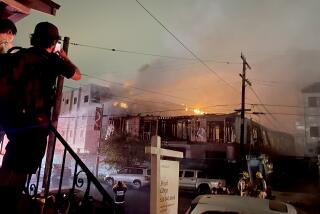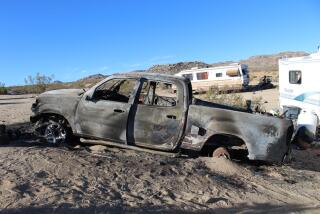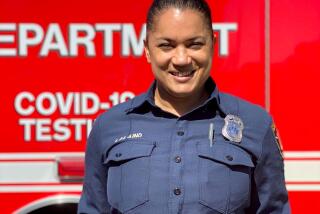Homeless woman set ablaze in Van Nuys still in critical condition
A pile of dried roses and burned-out religious candles sat on a Van Nuys sidewalk, reminders that a homeless woman was set ablaze there weeks earlier.
The bus bench on which Violet Ellen Phillips, 67, slept when she was attacked Dec. 27 had been removed. The portion of the sidewalk once shielded by the bench was left exposed, a lighter shade of grime than the rest, scarred with four holes where bolts had anchored the bench.
The assault, which authorities described as horrific, sent Phillips to the hospital with second- and third-degree burns. She remains in critical condition.
Homeless people may be seen as easy targets by perpetrators because they live on the fringes of society, homeless advocates said. In 2011, the National Coalition for the Homeless counted 105 attacks against the homeless by non-homeless people, the sixth-highest annual tally since 1999. One of those cases involved fire; 32 were lethal attacks.
“Homeless people in the eyes of the community are less than human and therefore an appropriate target for some people,” said Neil J. Donovan, executive director of the coalition.
At the makeshift shrine, an index card attached with Scotch tape said, “We are praying for you Violet love always.” It shook in a cold evening wind that whooshed through the intersection of Van Nuys Boulevard and Sherman Way.
“Give it two weeks, everyone will forget if they haven’t already,” said Jose Valle, a 48-year-old homeless man who walked by. “We’re invisible.”
Valle, wearing several layers of clothes and a black backpack, said he offered Phillips an extra sleeping bag in December and tried to give her a few dollars most times he passed her on his way to the tunnel where he sleeps.
Each time, Phillips, who bought a pack of Grand Prix cigarettes every morning with exact change, declined the offers with a polite, “No, thank you,” Valle said.
As Los Angeles Police Department detectives work to track down family members, Phillips remains at a local hospital with 20% of her body covered in burns, said Det. Chris Gable. She can breathe, but needs the help of a ventilator.
Without family members to provide a medical history, doctors are having difficulty making a prognosis. “One of the things that can help determine a survival rate is past medical history,” Gable said.
As is often the case for chronically homeless people, police have found few records for Phillips, not even records of police contact, Gable said.
Dennis Petillo, 24, of Van Nuys pleaded not guilty Dec. 31 to charges of attempted murder and mayhem. He is accused of dousing Phillips with an accelerant and setting her on fire as she slept on the bus bench. Authorities believe he is mentally ill. Gable said police are investigating a possible motive.
Wade Trimmer, director of the San Fernando Valley Rescue Mission, said he would see Phillips when she would shower at one of its mobile units. She said little about her personal life, but was always grateful, he said. “She always said ‘thank you’ and ‘God bless you for doing this,’ ” Trimmer said. “She’d been coming in for years.”
Children and elderly women are the most vulnerable of people living on the streets, Trimmer said.
“There are certain things homeless people accept about their lives. Being attacked or beat up is one of them,” he said. Trimmer urged that people take note of homeless people in their communities “so that when something like this happens maybe somebody can say, ‘Hey, I know who this is.’ ”
News of the attack brought back sad memories and frustration for Susanne McGraham Paisley.
Her brother, John McGraham, 55, died in October 2008 after he was doused with gasoline and set on fire with an emergency road flare by Ben Matthew Martin, who later pleaded guilty to first-degree murder, torture and arson causing great bodily injury. Authorities believe Martin sought revenge after being fired by his boss for hitting McGraham, a fixture in the Koreatown community.
McGraham Paisley was at a gym when she saw the news of the attack on Phillips on television.
Society looks at the homeless as lazy, McGraham Paisley said, yet most of them, like her brother, held jobs and lived under a roof for many years.
“When we imagine how we might die, one of the worst possible images is being set on fire. What happened to this woman was a tragedy,” McGraham Paisley said. “It makes me sad thinking that we, being such a powerful and affluent society, can’t reach out to these people.”
More to Read
Sign up for Essential California
The most important California stories and recommendations in your inbox every morning.
You may occasionally receive promotional content from the Los Angeles Times.










